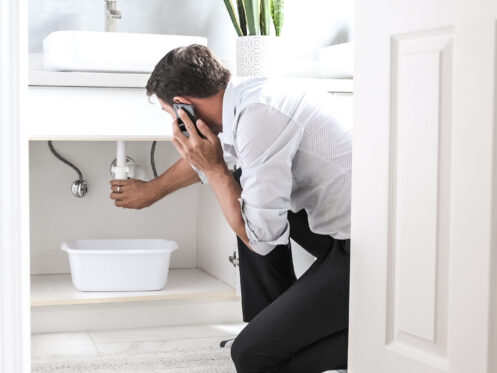Owning a vacation home is a great way to escape the hustle and bustle of everyday life. However, as the owner, there are several things you must do to keep the home in good shape. One of the most pertinent things is to winterize the plumbing each year. This will ensure the home is ready for your next vacation.
Drain All Water From the Pipes
Draining the water from the pipes is the most crucial part of winterizing the plumbing in your vacation property. Freezing conditions can cause pipes to rupture if the water stays within them and expands. To start draining the water, turn off the main water supply and open all the faucets, inside and outside the residence. Remember to unplug any equipment that uses water or ice, such as washing machines, dishwashers and refrigerators.
Not only should you drain the pipes, but you should also use an air compressor to blast out any leftover water in the lines. Doing this ensures there isn’t any standing water that can freeze and cause problems.
Shut Off the Main Water Supply
It is critical to keep the main water supply shut off once you have emptied the pipes of water. This will ensure that the plumbing does not get any more new water in it while you’re gone.
Be sure to shut the valve or switch off if your vacation property draws water from a private well. Leaving the water on can lead to major problems if pipes freeze and break while the system is running.
Insulate Exposed Pipes
It’s quite easy for exposed pipes to freeze, especially if they are in a cold place like a basement, attic or crawl space. To keep these pipes from freezing in the winter, an easy and practical solution is to insulate them.
You may want to think about running heating wires or heat tape along any exposed pipes for added peace of mind. Even in subzero temperatures, these electrical gadgets maintain a temperature that keeps the pipes from freezing.
Install Frost-Proof Outdoor Faucets
Outdoor faucets are very prone to freezing and bursting, which can lead to major water damage. The best way to keep this from happening is to install frost-proof outdoor faucets. These faucets work by draining any remaining water in the faucets back into the house. In doing so, there isn’t any water left in them to freeze.
Disconnect and Drain Outdoor Hoses
In addition to using frost-proof outdoor faucets, you need to disconnect and drain any hoses connected to them. Leaving the hoses attached increases the risk of water staying in the lines and freezing. Once you disconnect them, make sure to store them properly. You can do this by keeping them in a garage or shed. Many people even coil their hoses to keep them ready for summer and prevent damage from the cold. To coil the hoses, simply wrap or loop them into circular loops to create a compact, organized shape. Coiling helps prevent kinks and tangles that sometimes occur when you leave hoses in a disorganized pile.
Add Antifreeze to Toilets, Sinks and Drains
Once you drain water from all toilets, sinks and drains, there will still be a little moisture left in them. This is why it’s a good idea to pour a bit of antifreeze down these drains. However, you must be careful and make sure to use non-toxic plumbing antifreeze. Using car antifreeze could contaminate your plumbing system and potentially harm the environment. Pour about a cup of non-toxic antifreeze down each drain for the best results. This makes sure that there is enough antifreeze to combine with the remaining water to keep it from freezing.
Keep the Thermostat Set to 55 Degrees Fahrenheit
Maintaining a temperature of at least 55 degrees Fahrenheit in your vacation home is essential, regardless of how long you plan to be away. This temperature strikes the perfect balance between being warm enough to keep pipes from freezing and being low enough to save electricity. Upgrading to a smart thermostat is a great option for temperature control. This will allow you to control the temperature from your smartphone no matter how far away you are. You can even preset the thermostat to automatically adjust the temperature when it gets cold outside.
Open Cabinet Doors Under Sinks
You run the danger of frozen pipes if you keep cabinet doors closed because cold air will become trapped. Keeping the doors open allows the heat in your home to circulate and prevents the pipes from freezing. This is particularly crucial for pipes that run along outside walls since these locations are often cooler than the inside of the home.
Seal Drafts Around Doors and Windows
When cold air makes its way into your home by way of drafty doors and windows, the interior temperature will plummet. Once the temperature drops to freezing, the plumbing can burst. Sealing doors and windows with weatherstripping or caulking will help prevent this from happening. Be very careful to seal any cracks you find in the foundation or outside walls. These are common areas for plumbing lines to freeze. Not only does a good job of sealing drafts prevent frozen pipes, but it also makes your house more energy efficient.
Install a Water Leak Detection System
A leak detection system is a great investment for any home. They are particularly beneficial for vacation homes because owners sometimes leave them unattended for extended periods of time during the winter. If these systems detect a change in water pressure or moisture levels, they will send an alarm to your phone. Some systems even include automated shut-off valves that cut off the water supply when an issue arises. If a pipe freezes and bursts while you’re gone, this investment will help you avoid expensive repairs.
Close and Drain Swimming Pool Lines
Make sure you disconnect the water pipes to the swimming pool if your holiday home has one. You should also drain the lines that go to the pump, filter and heater. Water that gets stuck in these pipes during the winter might freeze and ruin the pool equipment. After draining the pipes, be sure to apply pool antifreeze to prevent any remaining water from freezing.
Drain and Winterize the Water Heater
Disconnect the water heater from its power source. Then, empty the tank of any water. To properly winterize a tankless water heater, refer to the manual that came with your unit.
Drain Irrigation and Sprinkler Systems
Winter is a dangerous time for sprinkler and irrigation systems. This is because any water that stays in the pipes from the previous year can freeze and create major problems. To winterize sprinklers and irrigation systems, you’ll need to drain all the water from the pipes and sprinkler heads. After draining the system, shield the exposed pipes and sprinkler heads from the cold by covering them with insulation blankets or foam pipe covers.
Bumble Bee Plumbing is here to help winterize your vacation home. We also provide water treatment solutions, repiping, tankless water heater installations, trenchless sewer line replacements and hydro jetting.
Call us now to winterize your home’s plumbing in Phoenix, AZ.

